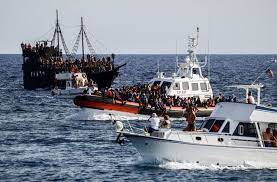ROME (AFP): Italy on Monday extended detention periods for illegal migrants to deter arrivals after record boat crossings from North Africa to Lampedusa saw the country’s southernmost tip overwhelmed.
Far-right Prime Minister Giorgia Meloni’s cabinet increased the time migrants due to be expelled from Italy can be detained from a maximum of 135 days to 18 months.
“It means that — and I sent a very clear message to the whole of Africa — if you rely on traffickers to break Italian laws, when you arrive in Italy you must know that you will be detained and then repatriated,” Meloni said in a television interview Sunday ahead of the cabinet meeting.
After landing, the vast majority of migrants who arrive in Italy are sent to reception centres throughout the country, where they stay while they await a decision on their asylum request.
Migrants Italy determines should be expelled are sent to so-called “permanent repatriation centres” (CPRs).
Last year only around half of those in CPRs were actually sent back to their countries when their detention was finished.
It was not clear what happened to the others, though migration specialist Alfonso Giordano, a professor at Rome’s LUISS University, said they were likely ordered to leave the country within a certain time frame — but it would be difficult to ensure they did so.
Giordano also doubted extending the length of detention would not work as a deterrent.
“Many of these people have suffered things during the journey that are incomparable to those they might experience on European shores,” he said.
The government hopes that a longer detention might allow more time for a higher rate of repatriation.
The cabinet’s decree must be converted into law by parliament within two months, during which it can be changed.
– ‘Secure Italy’s borders’ –
Italy has nine CPRs across the country, from Bari in the south to Rome and Milan, according to data from the country’s prison watchdog.
The time limit for detentions changes depending on who is in power, but it used to be 18 months between 2011 and 2014.
The existing CPRs can hold 1,161 people at a time.
Nearly 6,400 people passed through them in 2022, most of whom came from Tunisia, Egypt, Morocco, Nigeria and Albania.
Just over 3,150 were repatriated, the authority said.
Meloni — who won the general election last year on a vow to stop immigration — said on Sunday the defence ministry would also be charged with setting up more repatriation centres “as soon as possible”.
The government allocated 42.5 million euros ($45.3 million) at the end of 2022 for new repatriation centres, and the cabinet agreed Monday to task the military with building new centres in “sparsely populated and easily guarded areas”.
Nearly 130,000 people have landed in Italy so far this year against some 66,200 people in 2022, according to the interior ministry.
Last week around 8,500 people — more than Lampedusa’s population — arrived in just three days in hundreds of boats, overwhelming the migration centre, built to house 400 people.
Meloni has called on Italy’s European Union partners to share more of the responsibility for migrants arriving in the bloc.
European Commission President Ursula von der Leyen, visiting Lampedusa on Sunday, offered a 10-point plan to help Rome deal with the influx.
The plan is designed to combine a firm stance against people smugglers by making it easier for people eligible for asylum to legally enter the European area.
French Interior Minister Gerald Darmanin was expected in Rome later on Monday to discuss migration with his Italian counterpart Matteo Piantedosi, saying ahead of his arrival that France wants to “help Italy to secure its borders”.







